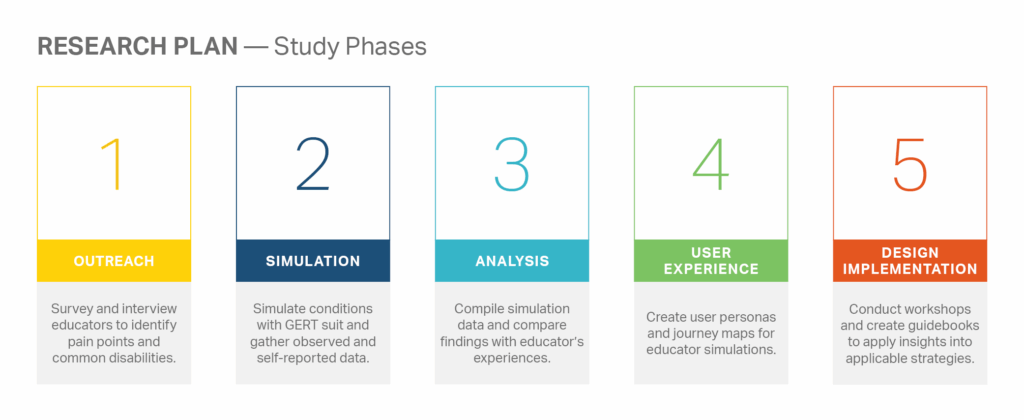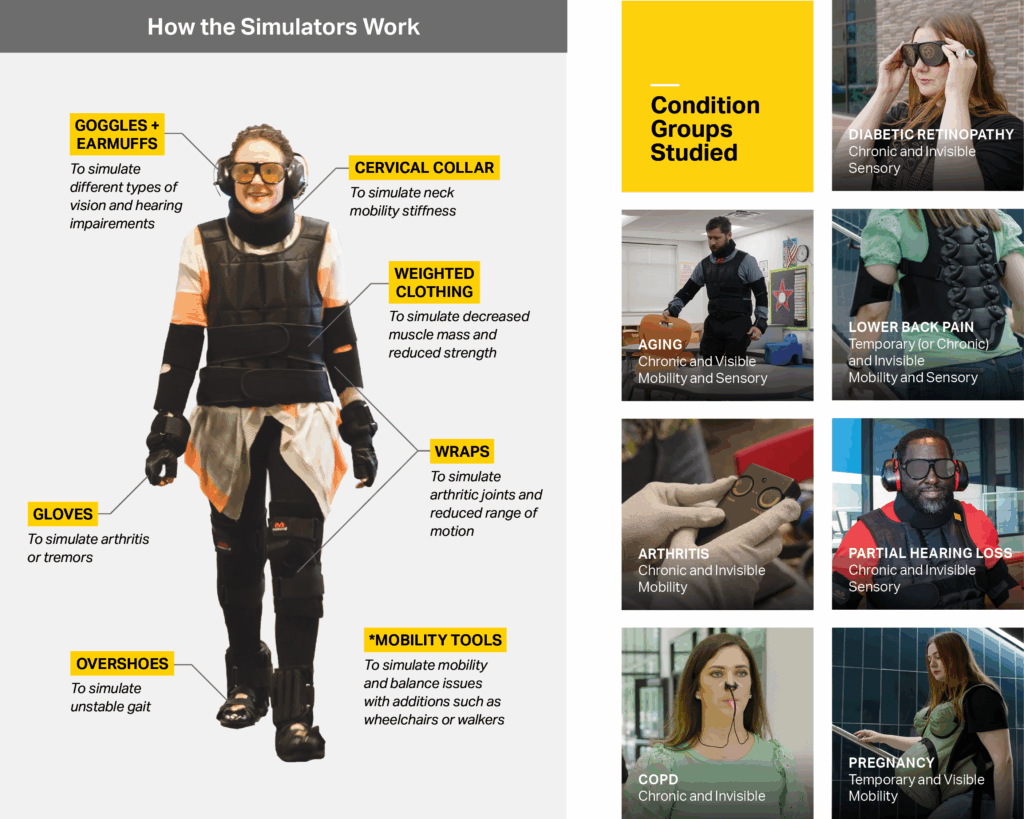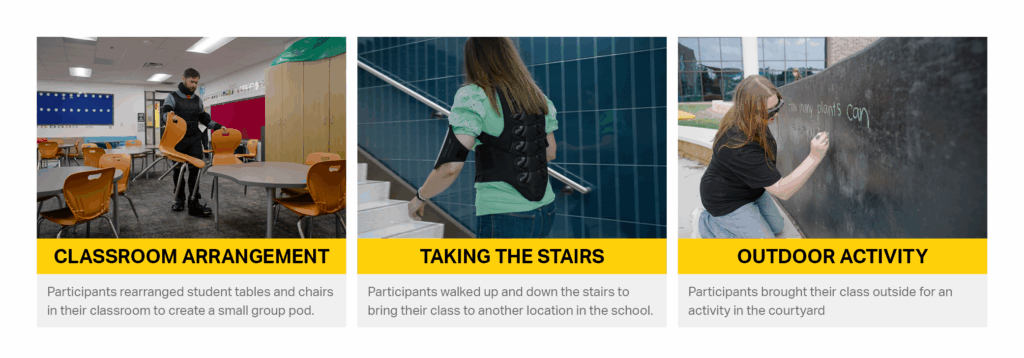While student health, wellbeing, and inclusivity are at the forefront of modern education, the needs of another important population have largely been ignored. Recent research found that approximately 12% of surveyed educators identified as having a disability or health condition that impacts their experience in the built environment. Much like the students in their classrooms, these educators embody a broad range of experiences — including physical limitations, sensory sensitivities, chronic health conditions, fatigue and chronic pain, learning differences, and more — that can contribute additional strain and stress to their already demanding roles. Understanding the perspectives, pain points, and unique value of educators with disabilities represents a valuable opportunity to enhance learning environments with much-needed support.
The Problem with Educator Burnout
In schools across the nation, increasing demands have educators’ work-related stress continuing to rise, contributing to educator burnout and pervasive challenges with teacher retention. Adding to the complexity of the issues of wellbeing and inclusivity in schools, educator burnout has also been tied to negative health outcomes, ranging from headaches and gastrointestinal problems to hypertension, illness, and dysphoric symptoms. These symptoms exacerbate the pain points teachers with disabilities already experience and increase the number of teachers experiencing health-related challenges in their professional environment.
The Unique Perspective of Educators with Disabilities
Research on inclusive education often centers on students with special needs, special education teachers, and related legislation – but there’s a gap when it comes to understanding the perspectives of teachers with disabilities. With the number of students receiving accommodations and support for disabilities at an all-time high, teachers with disabilities have a unique ability to understand and support their students — a fact that has great potential to impact the future of education.
“…developing and improving educational practices in order to promote better learning experiences for students with disabilities and learning disabilities was found as being one of the main drivers that led these men and women with disabilities to become teachers themselves.”
– Patricia Neca, Maria Leonor Borges, and Paula Campos Pinto, 2022
Recognizing the opportunity to better support educators with disabilities, an American Society of Interior Designers (ASID) Foundation research grant funded Corgan’s primary research with the goal of increasing visibility and insight into how design can create supportive environments for all users. Partnerships with Thornton Elementary School and professional organizations across the Dallas-Fort Worth region enabled authentic engagement, offering real education environments and teacher participation in interviews and simulation exercises.

Inside the Research Approach
The study was guided by a five-phase research plan designed to capture the lived experiences of educators with disabilities so they could be translated into strategies for healthier, more inclusive learning environments. Research began with an initial literature scan, which surfaced existing knowledge on teachers with disabilities, resilience, and accessible design. These early findings shaped the participant recruitment strategy, and informed which conditions and experiences were important to represent in the study.
Through outreach, the research team engaged a broad pool of educators, gathering input from survey responses and conducting in-depth interviews to ground the research in firsthand insights. Building on this foundation, simulation exercises were developed to reflect common classroom conditions and stressors, complementing the stories shared in interviews and strengthening the evidence base. In the analysis phase, insights were synthesized into recurring themes and opportunities, leading to the creation of user experience maps and personas. The study concluded with design implementation workshops, where educators, designers, and researchers worked together to co-create strategies rooted in empathy and evidence.
Educator Insights and Lived Experience
In-depth interviews served as a cornerstone of this research, offering a window into the realities of teaching for educators with disabilities. Across 41 sessions, current and former teachers shared the everyday demands of their profession, health conditions, barriers, and adaptations shaping their work. Overwhelmingly, these interviews also shed light on resilience and loss — stories of adjustments and adaptations and ultimately, accounts of educators leaving the profession when the conditions became untenable. Importantly, the interviews also uncovered systemic challenges unrelated to individual circumstances: physical and cognitive barriers, heightened sensory stressors, and organizational hurdles embedded in the school environment. Many participants spoke of the invisible labor required when teaching with a disability — constantly reconfiguring one’s routines, negotiating spaces, and compensating for design shortcomings. The insights grounded the research in real, embodied experience, deepening designers’ empathetic understanding of teachers’ needs.

Simulated Experience: Revealing Hidden Strain
Using wearable disability simulators that limit movement, add weight, or alter sensory perception, the research team created simulated experiences that gave teachers without disabilities the opportunity to experience schools differently and reflect on how the environment shapes their daily work. By engaging directly with recreated scenarios, educators were able to voice when circumstances created added strain and where support was needed most. These reflections revealed patterns that often remained hidden through conversation alone, giving researchers a deeper understanding by highlighting consistent stressors that emerge with added limitations and revealing immediate opportunities for design intervention.
Simulated conditions reflected common educator challenges identified through the literature scan and interviews. These condition groups included diverse disabilities and conditions, both visible and invisible, chronic and temporary. Through specialized wearable simulators, the study explored the impacts of physical and sensory conditions, ranging from aging and pregnancy to partial hearing loss and COPD. Impacts on performance were gathered through self-report, observation, and measured physiological response.

Held in an authentic school setting, the experiment recreated a “day in the life” of teaching to capture how environments support or hinder educators. Participants completed a series of activities selected to reflect typical demands that could be intensified by their assigned disability condition group. Activities like the “classroom arrangement” task challenged mobility, dexterity, and endurance, while the “outdoor activity” task participants experienced challenges with balance, navigation, and sensory perception. Each educator performed the same tasks once without the simulator as a baseline and again with the assigned condition for comparison.
Data from the experiment showed how simulated conditions magnified the myriad challenges of teaching. Compared to baseline, tasks were rated as nearly twice as difficult, correlating with noticeable declines in confidence and perceived success. Self-efficacy dropped sharply, especially in aging and respiratory conditions, where routine classroom activities felt less achievable. Mood and energy levels also dropped, underscoring the emotional strain of facing additional barriers. Physiological measures reinforced these findings, particularly with age-related conditions during mobility-intensive tasks like walking through the campus or bending down to engage with students seated on the floor. Together, these findings not only highlight how everyday teaching demands can become taxing, but the critical importance of environments that support resilience.

Design Through Co-Creation: Moving Inclusivity Forward
To translate research findings into actionable design strategies, a diverse group of educators, architects, interior designers, and researchers came together for a collaborative design workshop. Interactive and hands-on, the session focused on how thoughtful design could infuse learning environments with support for health, wellbeing, and professional needs. Working in mixed groups, participants ideated design interventions for educator personas representing a range of disabilities and health conditions. Next, groups focused on developing design strategies for key education space typologies. The powerful convergence of perspectives and expertise that the workshop facilitated yielded supportive strategies at a variety of scales.
Designing for educators with a broad range of disabilities represents an opportunity to enhance inclusivity in our schools and to meaningfully address educator burnout. With a focus on promoting health and wellbeing for teachers, this research has consolidated the experiences of diverse educators, yielding actionable strategies for change. Design strategies and key insights will be shared in a resulting research report and open-source design guidebook, which are currently in progress. These insights and resources (to be featured in the second part of this article series) are intended to provide thoughtful, supportive design strategies that can be implemented at a variety of scales — from individual adaptations to broader best practices for new school facilities. Educators benefit from inclusive education environments that help them to not only to survive — but to thrive.

